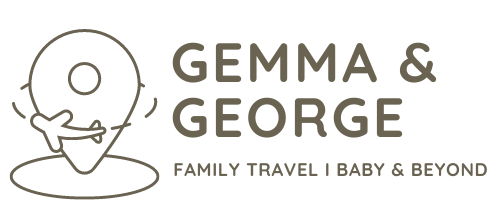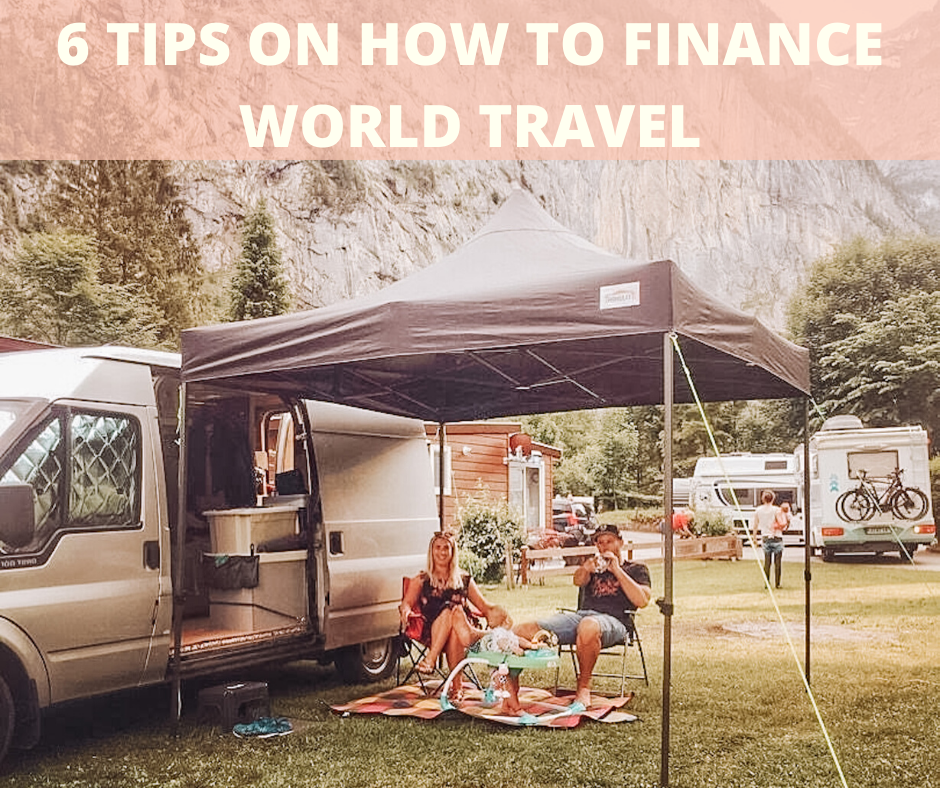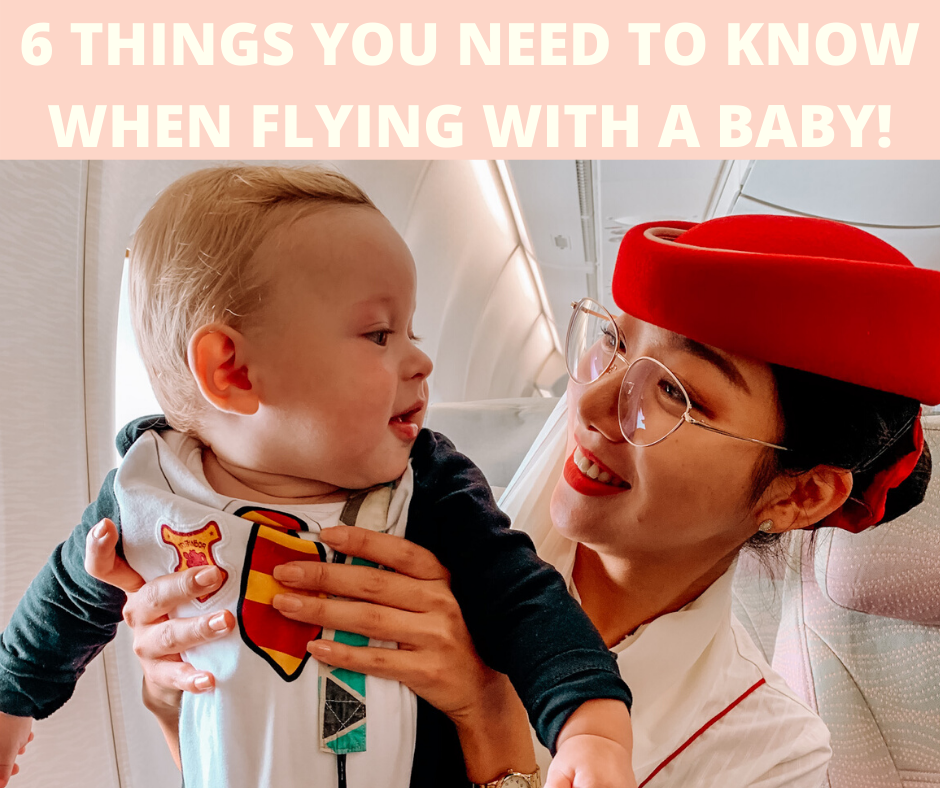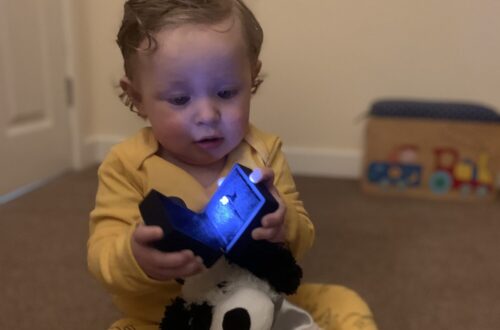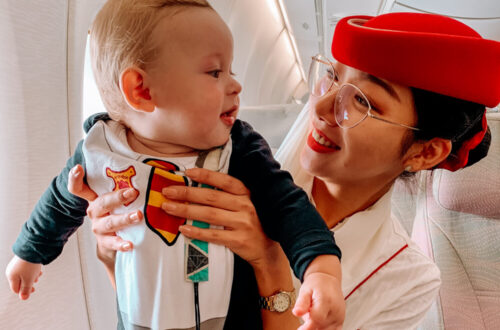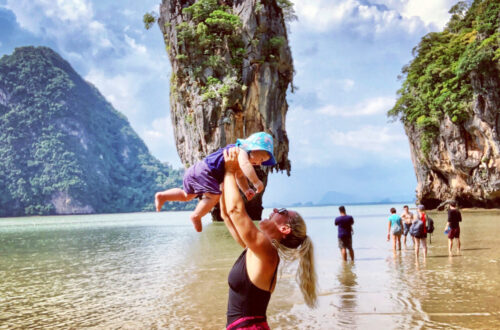HOW TO FLY WITH A BABY
Thinking about booking your first travel adventure with your baby? You might be asking yourself practical questions, “Where do you change their nappy?” “Where does my baby sit?” or “Will it hurt them?” I’ve experienced both short and long haul flights to America, SE Asia and Europe with my son, since he was 12 weeks old.
At first it seems overwhelming, but in this post I’ve tried to break down everything you need to know, pack or be aware of in a helpful order. You can read my first experience of flying with George and check out some quick tips to help your flight be stress free.
Table of Contents
PRIOR TO FLYING
WHEN CAN I FLY?
There are no standard regulations about the minimum age a baby can fly although age restrictions do vary between airlines. It ranges from a minimum of 2 days old to 2 weeks old. If you’ve had a Caesarean section you may not be allowed to fly until getting the all clear from a GP at the six week postnatal check-up.
In any event, always check with your GP and airline before you travel. Some doctors will encourage you to wait until baby is at least six weeks old – babies are still developing their immune systems before this time and need time to adjust to their new surroundings, so it can be unwise to fly.
RECOVERY
Another factor to consider is whether YOU are ready to fly with your infant. Air travel with a baby does require a lot of organisation, effort and focus, so make sure you’re feeling up to the task! Give yourself time to rest and adjust to having this new special little person in your life
TRAVEL DOCUMENTS
Your baby will need their own passport. Be sure to have applied for your baby’s passport in advance of your trip to avoid disappointment. Check whether your destination requires a VISA/ESTA. Apply in advance.
Printing your tickets in advance or checking in online before heading to the airport can also save time. If you are flying alone with a child that does not share your last name, you may be required to bring copies of a birth certificate or adoption certificate. Use the table below as a basic checklist:
| AIRPLANE TICKETS | VISAS | ESTA (USA) |
| ACCOMMODATION INFORMATION | CARE HIRE INFORMATION | EUROPEAN HEALTH CARD |
| DRIVING LICENSE | TRAVEL INSURANCE DOCS | MEDICATION PRESCRIPTIONS |
TRAVEL VACCINATIONS
In Britain there are no specific vaccines for travelling. There are however, vaccines that your baby is scheduled to be given, these are administered by your GP at 8 weeks, 12 weeks and 16 weeks. Unfortunately, you cannot request for your newborn to get their injections early. There must be a 28 day gap in between each dose.
However, you can get these immunisations abroad. We travelled to Singapore before George was 12 weeks old and sought out an international Doctors and had them done there. Remember to take your baby’s red medical book, we never leave without it.
DESTINATIONS
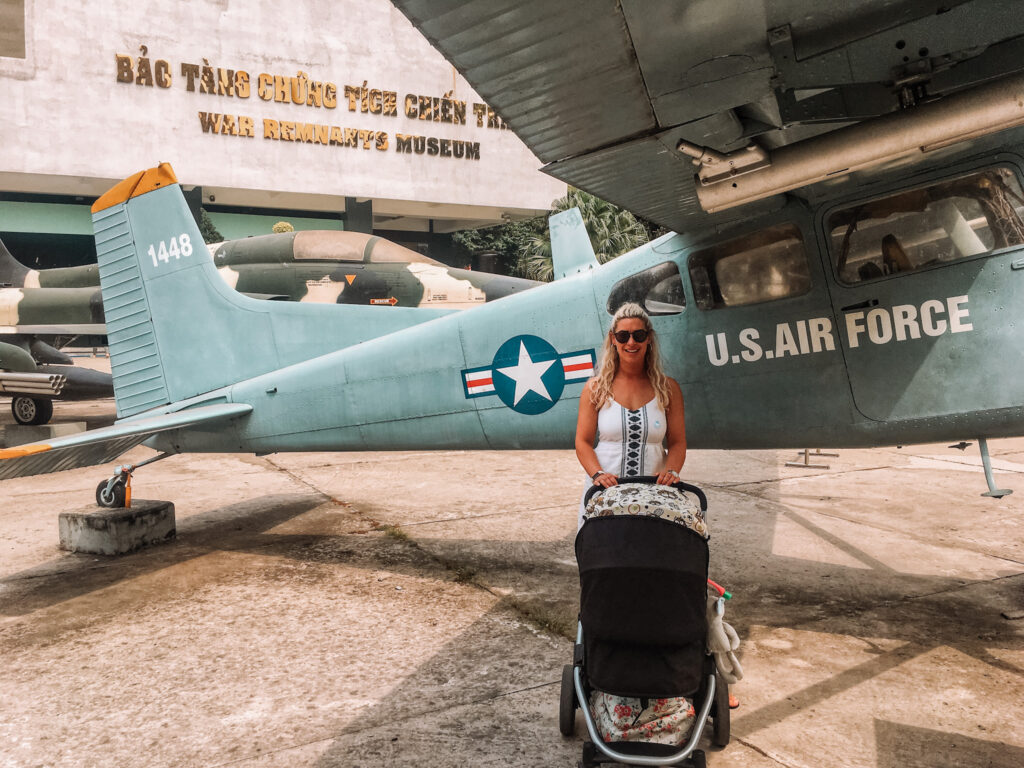
The world is your oyster! Avoid destinations experiencing violent conflicts. The British Government website has a comprehensive list of destinations for the public to access. Check your selected country has no public health risks. Avoid yellow fever or malaria.
AIRLINE BOOKINGS
COST
You can expect to pay approximately 10% of the adult fare for an infant air fare or those under 2. If your baby is older than 6 months and can sit up without assistance, you may want to book them their own seat. We recommend reserving a bassinet for long haul flights, where possible.
CHOOSING A FLIGHT
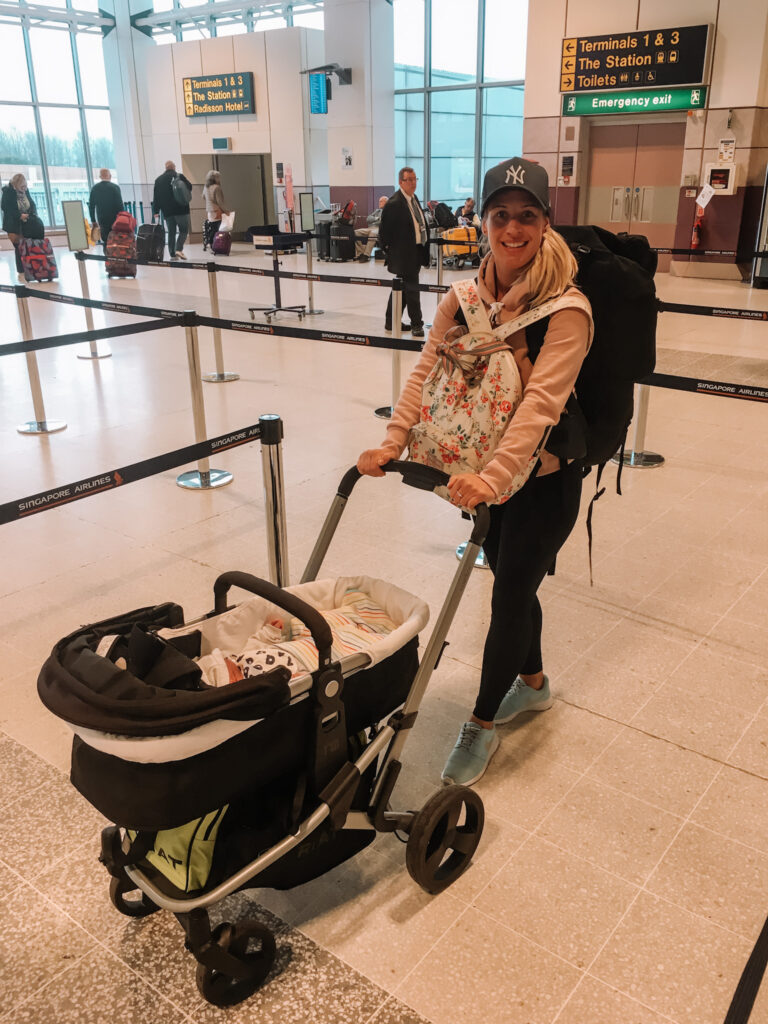
Do your research. I use Skyscanner as a base, alongside searching for accommodation in the chosen destination area using Booking.com or Airbnb. Cheap flights sometimes means expensive accommodation, always check before purchasing flights.
Take into account your baby’s routine (nap and feed times) and select a flight that works for you. You won’t know until you try. Personally we book day flights, but I know of fellow travel mums who swear by night flights. Each to their own.
BABY SEAT?
Infants under two can sit on your lap during a flight rather than take up a seat. You will be provided an infant belt that attaches to your own belt for take-off and landing. For long haul flights we recommend reserving a bassinet or purchasing a Skybaby Travel mattress. To learn more about the mattress read our review 🙂
BOOKING THE RIGHT SEATS
When flying with a baby, I recommend booking the front row bulk head seats. You can do this online when booking your flights. If not, contact the airline as soon as possible to request your reservation. Many airlines have baby bottle icons, to show which seats are baby friendly.
More often than not, on larger aircraft there are the front row bulk heads. On short haul there are either towards the front or back of the plane. The icon represents that the seat has an additional air mask for your baby should there be a need for it.
WHAT IS A BASSINET?

Airlines have different versions of a ‘bassinet,’ but the function is the same. It’s a crib/cot for your baby that attaches to the cabin wall. Seats allocated for parents wanting to use a bassinet, are towards the front of the plane, directly behind premium economy.
Most companies have a policy that states, bassinets must be stowed during take off, taxi and landing. So you will have to hold or have your baby on your lap for those parts of your flight. Once take off is complete you will be allowed to use the bassinet. Some companies will ‘build it’ for you. Another version is the equivalent of a baby chair.
If you are on a long haul flight, you can attach toys and put other ‘baby essential’ items in and around the bassinet for ease throughout the duration. Despite the airline and design, your baby will need to be strapped in somehow when they are in the bassinet.
You may also be instructed by attendants to remove your baby if the plane experiences bad turbulence. Some budget airlines do not have bassinets, neither do most short haul flights. It isn’t a necessity. But if it’s there definitely reserve one. It will help reduce stress for you and for your baby!
Booking.com
BAGGAGE ALLOWANCE
Check with your airline prior to departing, as allowances vary. Generally, you are permitted one carry on bag and one check in bag. With some airlines, infant fare (travelling with baby on your lap) will permit an additional carry on bag for your baby. If, however your baby has their own ticket and seat, they will have a standard adult passenger luggage allowance.
CARRY-ON
Some airlines, (mostly budget) may not allow your baby to have their own carry-on luggage for free. You can either pay extra or combine their items with your own. As always, organisation prior to flying is key to a successful flight with a baby. Use zip lock bags, and store in sections for easy locating.
PRESCRIBED MEDICATION
You are allowed to take liquid prescribed medicine, larger than the 100ml limit, for your baby onto the aircraft with you. As long as the name prescribed on the label of the bottle/medicine matches the name on your babies passport. You may be asked to prove this when passing through security.
BABY MILK
In the UK and most international airports you are allowed to exceed the 100ml regulations. This includes breast milk that has been expressed. Note that you may be asked to taste or drink a little to prove that it is what you claim it is. In America, if you wish to take bottles of milk over 100ml you have to consent to a full body search (this only applies to travels who are not American residents). Here are the UK guidelines.
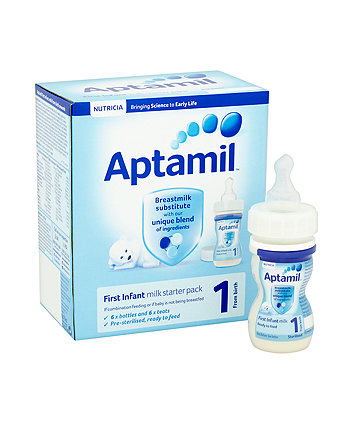
CAN I TAKE MY PRAM?
Most airlines will not charge you for taking a pram on to the air craft (check the airlines policy). The majority of airports allow you to use your pram/stroller through check-in and security, parting only with it at your departure gate. It is then stored in the hold of the plane.
Once you have arrived at your destination, you can collect your pram from the side of the plane, luggage belt or ‘oversized’ counter. Every airport differs so be sure to ask your a member of your air crew before you land. We always use our pram, and take our baby carrier in our luggage. There is no right or wrong, only what works for you.
CAR SEATS

There is no additional charge for taking a car seat with you If you intend on renting a vehicle in your chosen destination, take a car seat with you. we recommend checking it in with the rest of your luggage. That way you don’t have to lug it around the airport with you. We take a car seat only if we are renting a car.
AT THE AIRPORT
CHECK IN WITH A BABY
Once you have located your desk, you will have to wait in line with other passengers. On occasion you may be prioritised but it is rare in the UK. Your baby needs to be present at check in, as do you. You may find it easier to give your baby a little feed/nappy change before joining the queue.
You can check in your luggage, car seats and a pram (if you don’t want to use it for the airport). More often than not, you are required to take the pram or car seat to a separate counter for oversized items.
AIRPORT SECURITY WITH A BABY
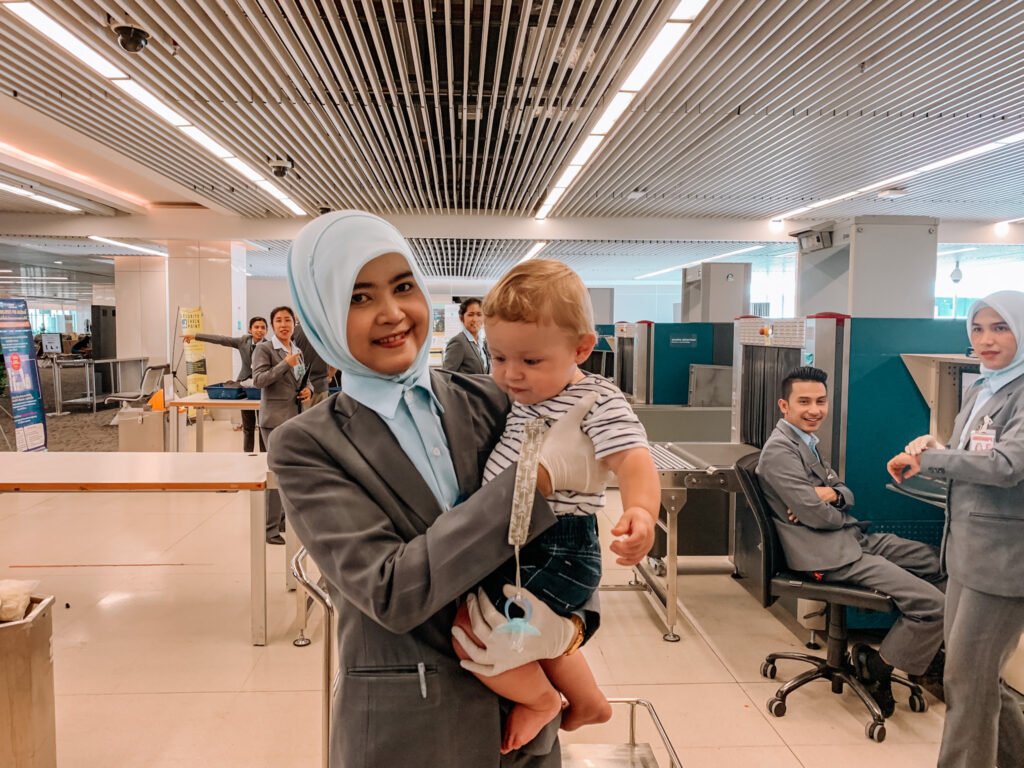
Most airlines will prioritise you and direct you to the fast track or family lines. Before leaving the house, I ensure all liquids are in a clear zip lock bag (including baby milk). All bags and your pram will need to be placed on the belt, to be scanned. If travelling with a thermos flask, it is best to put that in a tray also. The X-Ray machine cannot scan through it and it always causes delays.
You may be required to remove your shoes, hat, jacket etc. whilst still holding your baby. Once your belongings are on the belt, you will then be asked to walk through metal detector, with your baby. If your baby has a hat, blanket on etc. you will be asked to remove it. Airport staff may ask to gentle ‘pat down’ your baby.
Outside of the UK, USA, some airports allow you to keep your baby in their stroller when going through the metal detectors. Once through, they may then pat down or wipe down the pram.
AIRPORT FACILITIES
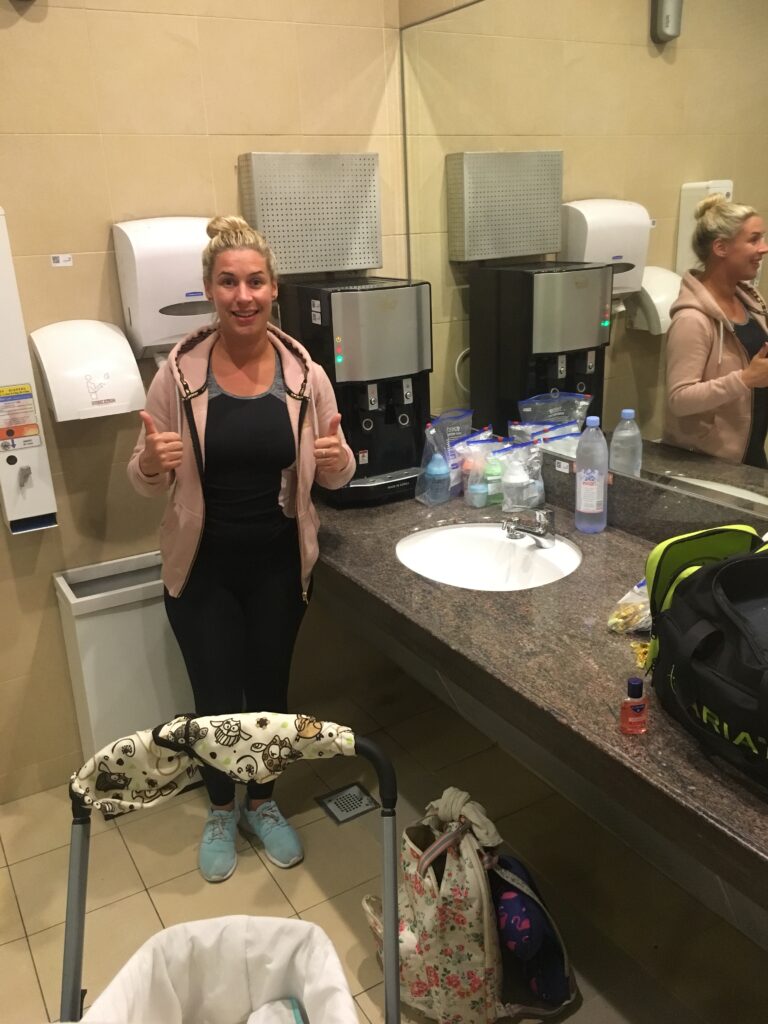
Most airports will have the basics, a changing table within either the ladies toilets or the disabled toilet. Facilities vary from Country to Country. Not all have feeding rooms, or changing mats available for Fathers. Once through security, we always take a walk to see what is available and locate a quiet place to feed or for George to nap.
BOARDING GATE
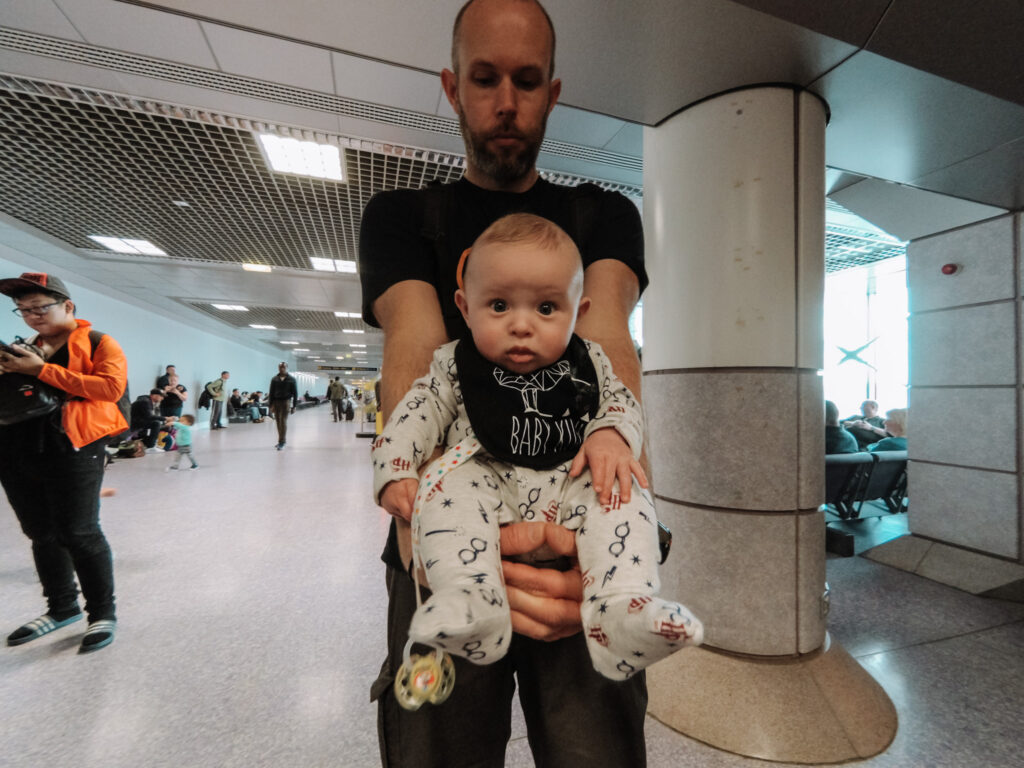
If you have chosen to keep your pram, this is where you will part with it. We always make a point of going to the desk and informing staff that we have a pram and a baby. This usually results in you being asked to board first, and staff will take your pram around 5 minutes before boarding opens. Your pram is either taken at the gate or at the side of the aircraft and stored in the hold. Every airline is different, so we recommend letting staff know, to avoid any delays.
ON BOARD THE FLIGHT
ON FLIGHT FACILITIES
Not every toilet has a changing station. Once on board, take a minute to note where the toilets are located and which ones have a baby changing station. The station is a flat piece of plastic that folds down. There are no edges or buckles to keep your baby safe. Only you. And with turbulence, it can be quite tricky.
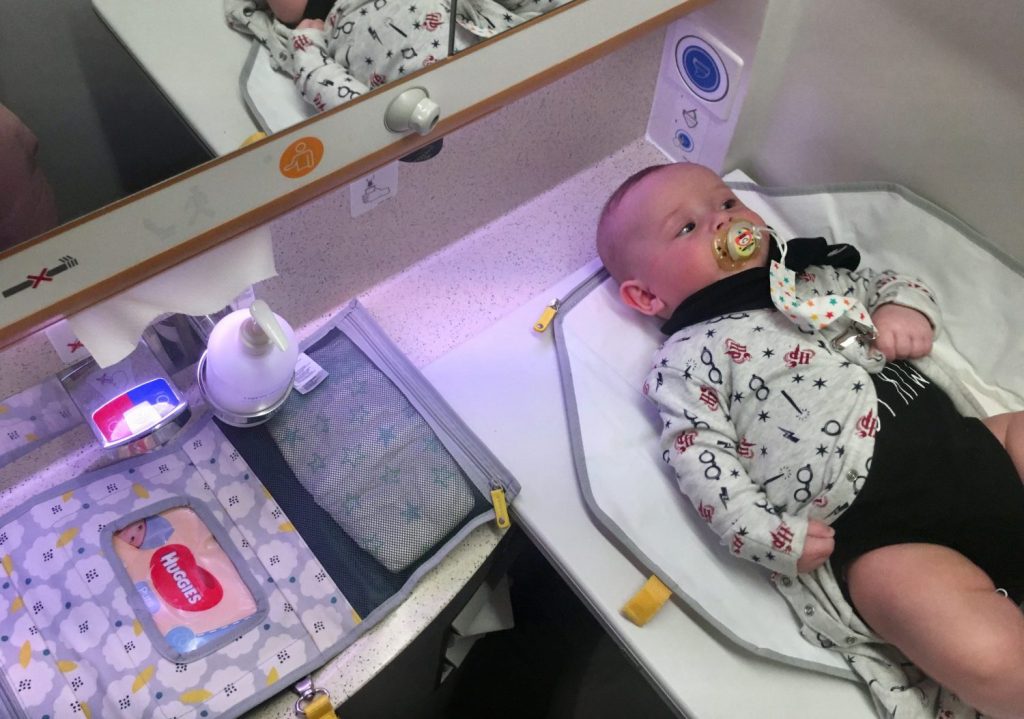
Space is limited so take only what you need with you into the toilet. You will either have to place your nappy change bag on the floor or spread out across the sink. Never leave your baby unattended. On short haul flights, the toilet cubicles are even smaller. To avoid germs, wipe the station before placing your baby mat down.
FEEDING YOUR BABY
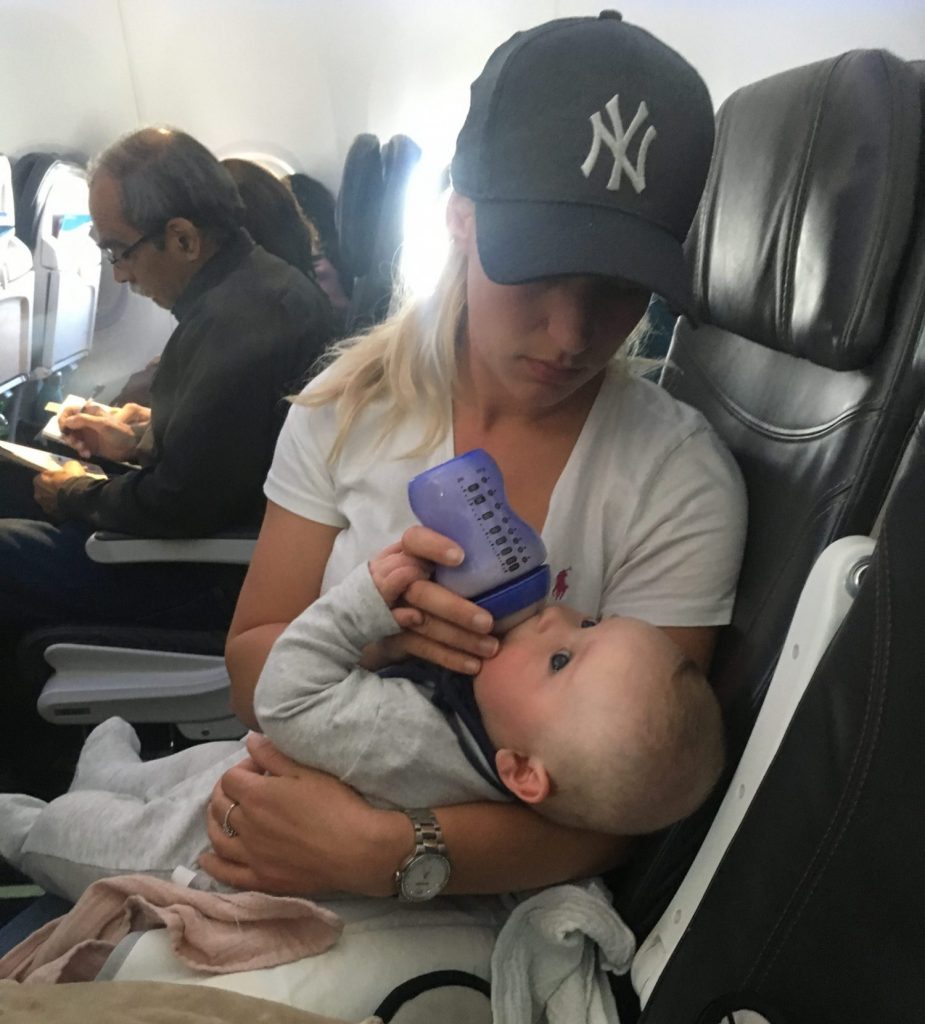
You can breast feed your baby whilst on the plane, I have seen some mothers who prefer to use a cloth or cover to provide some privacy and others who didn’t. Whatever works best for you. Having a window seat does provide more privacy than an aisle seat, so take that into consideration. For bottle feeding parents, take a thermos flask and ask cabin crew for hot water. For more information on bottle feeding abroad, click here.
RECOMMENDED FOR YOU


